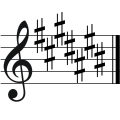A-sharp minor
A sharp minor is a key of the tonal family minor, which is built on the root a sharp. The key of A sharp minor is written in musical notation with seven sharp accidentals (F sharp, C sharp, G sharp, D sharp, A sharp, E sharp, H sharp). The corresponding scale and the fundamental chord of this key (the tonic a sharp-c sharp-e sharp) are also designated by the term a sharp minor.
Because of the seven accidentals (one could represent A sharp minor - enharmonically reinterpreted - more simply with B flat minor), this key has presumably only been used by Johann Christian Heinrich Rinck in his 30 two-part exercises through all keys.

![]()
![]()
![]()
![]()
![]()
![]()
![]()
![]()
![]()
![]()
![]()
![]()
![]()
![]()
![]()
Key classification
| Keys and their accidentals | |||||||||||||||
| Portent: | 7 ♭ | 6 ♭ | 5 ♭ | 4 ♭ | 3 ♭ | 2 ♭ | 1 ♭ | 0 ♭/♯ | 1 ♯ | 2 ♯ | 3 ♯ | 4 ♯ | 5 ♯ | 6 ♯ | 7 ♯ |
| Major keys: | Ces | Ges | Des | As | It | B | F | C | G | D | A | E | H | F# | C sharp |
| Minor keys: | as | it | b | f | c | g | d | a | e | h | F# | cis | gis | dis | ais |
Questions and Answers
Q: What is A-sharp minor?
A: A-sharp minor is a minor scale based on A-sharp. It has seven sharps in its key signature.
Q: What is the relative major of A-sharp minor?
A: The relative major of A-sharp minor is C-sharp major.
Q: What is the parallel major of A-sharp minor?
A: The parallel major of A-sharp minor is usually replaced by B-flat major, because A-sharp major's three double sharps in the key signature makes it generally impractical. Exceptions include Chopin's Polonaise Fantaisie in A flat Major, Op. 61, which has a short passage written in A sharp Major with accidentals.
Q: Does this key have an enharmonic equivalent?
A: Yes, the enharmonic equivalent of A sharp Minor is B flat Minor. This key is often used instead of A sharp Minor since it isn't very useful for compositions and it's one of the least used keys in music.
Q: Are there any composers who have composed music in this key?
A: Yes, Christian Heinrich Rinck wrote his Prelude No 16 from Op 15 in this key.
Q: Why does B flat Major replace the Parallel Major for this scale?
A: B flat Major replaces the Parallel Major for this scale because having three double sharps as part of its signature makes it impractical to use otherwise.
Search within the encyclopedia














